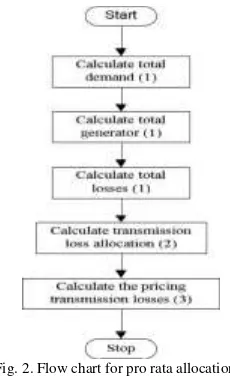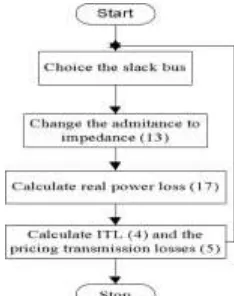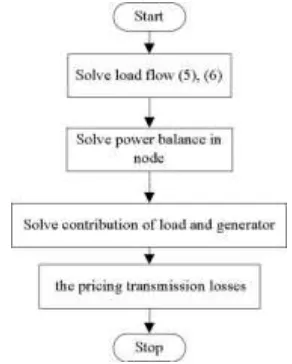The Pricing Transmission Losses in Competitive Electricity
Market in Bilateral Contract Market
Didi Istardi
Batam Polytechnics
Electrical Engineering study Program
Parkway Street, Batam Centre, Batam 29461, Indonesia E-mail: istardi@polibatam.ac.id.ac.id
Abstract
In power system network, transmission losses is the main factor that must be consider in transportation energy from generator side to load side. In competitive electricity market, the pricing transmission losses must be allocated to the all market participants. This pricing must have economic efficiency on competitive operation of the power systems. Therefore, it is important to provide good methodologies that allow determining a loss allocation among market participants as accurate and fair as possible. In this paper, the transmission loss allocation will be implemented in bilateral contract market using several methods, pro rata, incremental loss allocation, proportional sharing, and unsubsidized marginal allocation.
Keywords: Transmission loss allocation, bilateral contract, electricity market.
1. Introduction
Transmission losses are an important component in transferring electricity from generation side to demand side in power systems, especially in deregulated power market systems that the transmission losses price normally are charged proportionally to the all participant in the all type of electricity market. Therefore, the methodologies and calculation of the pricing transmission losses must be accurate result, fair allocation, efficient algorithm and technically easy to be implemented [1].
Some researches already discussed about the calculation of the pricing transmission losses [2-4], the cost of transmission transaction has four main components. Firstly, operating cost is production cost that related to redispatch and rescheduling of generation resulting from the transmission transaction. This cost usually use to
maintaining the system voltages, reactive power support and line flow limits. Seconds, opportunity cost is related to benefits of all transaction that happen due to transmission service operation. Third, reinforcement cost is the capital cost of installation a new transmission facilities to accommodate transmission transaction. And the last, existing system cost is a cost of using the existing
transmission facilities that already installed. This paper only focus in operating cost calculation using transmission losses allocation.
Unfortunately, it is not easy to estimate and calculate transmission losses because it is non linear function of power line flow [4]. Therefore, the calculation of transmission losses is not only difference between a given generator and demand. According to this non linearity and the components of transmission pricing, this paper will discuss about the right method to calculate the pricing transmission losses in bilateral contract market.
of auction: day ahead market, hour ahead market, real time market, etc. In bilateral contracts, generating utilities and customers contract each other for selling and buying power. The seller arranges the transportation of the contracted power over the transmission network. In hybrid market model, the electricity trade using power pool market and bilateral contract.
Bilateral transactions are contracts between power sellers (Gencos) and buyers (Discos or large customer). The bilateral transaction is a long term contract and the price is based on market force [5]. In bilateral transactions, the power seller will inject the bulk power into transmission system and the buyers will take an equal amount of power from the network. In this paper following assumption will be used: multiple candidate power suppliers (generation set) and power customers (load set), the amount of transaction MW is known, the reactive power is compensated locally, and transmission system has enough capability to carry this transaction. The model of the bilateral contract market can be shown in Figure 1.
demand (MW). The transmission losses allocations, L, are describes in following subsection.
A. Pro Rata Allocation (PR)
This method usually allocates equal losses in generation and load [6]. Therefore, the transmission loss allocation can be express as
Where Lgi are the losses allocated to the generator i, and LDj are the losses allocated to the demand j. Generator and demand loss allocation factor (Kg, KD) are identical for all buses. In this method, the loss allocated in generators and demands are always positive. The pricing transmission losses can be calculated by
Where Rgi are the pricing transmission losses for generator i, and RDj are the pricing transmission losses for demand j, TC is transmission cost. The algorithm for this method can be seen in Figure 2.
In this method, the network structure is not the main subject to solve these losses. Whatever the network configuration, the pro rata method only look into generator and load side.
Fig. 1. Model for bilateral contract market [5]
The important thing in bilateral market is that the markets need in order to improve economic efficiency in knowledge of the transmission losses associated with each proposed bilateral transaction. This knowledge permits buyer and sellers to in cooperate the level and cost of losses into their negotiations to find the optimal price of the pricing transmission loss.
3. Transmission loss allocation methods
In general and simplicity, the transmission losses is difference between the sum of all generation and the sum of all demands and can be express as
, , (1)
Where Pg is total active power generated from generation side (MW), PD is the power that consume by
Fig. 2. Flow chart for pro rata allocation
B. Incremental Transmission Losses (ITL)
It should be remember that ITL in slack bus is zero. The power flow can be solved using the basic Kirchoff’s Laws for active and reactive power:
Where V are voltages at buses (kV), Y are admittance matrix, θ is angle associated with Y, and δ is angle associated with V.
From (4) and (5), the transmission losses allocation can be calculated using different methods.
First method is using the exact power method [9]-[10], using a Newton-Raphson power flow calculation from (4) and (5) to find the active and reactive losses. This method begin with identifications of transaction pairs by assuming that no real power loss in individual transaction.
Where T is transaction pairs, PkT is real power loss of transaction T.
Then solve power flow analysis and nodal power balance using (4) and (5). The injected current in bus must be express:
and
Where Ii is current in bus i, and S are the real power(kVA).
Then solve the active and reactive power loss for individual transaction:
The effective of this method depend on choice of slack bus. The algorithms of this system can be seen in Figure 3.
Fig. 3. Flow chart for incremental transmission losses using exact power
The simplification of the exact power method is Z-bus loss allocation [11]-[12], where in this method the admittance matrix in equation (6), (7) change into impedance matrix. This method solve the AC power flow and the system transmission losses can be calculated among the n network busses according to
The loss component, Lk, is the fraction of the system losses allocated to the net real power injection at bus k and can be calculated using the network admittance matrix.
From equation above, can be separate the real and imaginary losses.
The second term from equation (16) is zero. Therefore, the loss component that associated with bus k can be calculated using equation (17)
The fastest method to calculation transmission losses in ITL is using DC-OPF loss allocation method [14]-[15]. The partial derivative of the total loss with phase angle can be represented in equation (18)
From the equation (18) above can be calculate the ITL
After calculating the ITL, the preliminary loss (Lp) that allocated to generator n and i can be express as
and
This loss component depends primarily on the complex bus current injection rather than power injection. The Z-bus method is not sufficient for very large network. Therefore, the new concept in calculation transmission loss is introduced. This method is a circuit based method for multi area transmission network [13]. It uses Z-bus loss allocation as basic to calculate the transmission losses and the large network divide into some area. This methodology comprise into four steps, allocation of local network losses, excluding the virtual agents losses, allocation of interchange losses due to wheeling power through other network area and tie lines, and allocation of interchange losses among all generators and demands. The algorithms for this method can be seen in Figure 4.
Fig. 4. Flow chart for incremental transmission losses using Z-bus
And the loss allocation rates can be calculated as
and
So, the loss allocation to generator n becomes
C. The Proportional Sharing Methods
The proportional sharing describe that each node as a perfect mixer, where power flowing out of a node is reckoned to be proportional sum of the power flowing into node [6],[9]. There are three ways to calculate transmission loss allocation of proportional sharing, Acha et al’s method, Bialek’s method, and Kirschen et al’s method [16].
In Acha’s method, losses are allocated by using concept of dominion (centre of the power tracing algorithm and can be found from load flow solution) and can describe as power auditing algorithm.
The dominion’s contribution can be calculated
(24)
from the loads to generator sources. The power balance equation at node i considering the power inflow from upstream can be express as
The transmission loss allocation also can be calculated using nodal basis as be proposed in [17]. Line power flows are first unbundled into a sum of component, each correspondent to a bilateral transaction. Then with mutual coupling among the components appearing in the line losses can be solved. In this method, the total loss allocation for i transaction can be estimated by quadratic expression in equation (32)
Where A are upstream distribution matrix.
The last method is Kirschen et al’s, where the network is divided into ‘domain’ of each generator. In this method, uses the assumption of proportionality that a basis of the recursive method for determining contribution of each generator to the load in each common.
Where F is flow on the link. And the algorithm for the proportional sharing method can be seen in Figure 5.
Fig. 5. Flow chart for Proportional sharing application
D. Unsubsidized Marginal Allocation
This method will avoid the negative losses with change the consistent manner in incremental transmission losses [9]. The slack bus is change in such way that the generator ITL coefficient with smallest value will become zero. This makes the generator losses will always positive. The total transmission loss can be express as
(33)
And can be decomposed into a self and t-1 mutual
Splitting of the cross term into two components that reflect the contribution of every transaction.
In this method, there are three different scheme that can be considered to calculated the transmission loss allocation; proportional, quadratic and geometric allocation. For proportional allocation can be expressed as
For quadratic allocation
And for geometric allocation
4. Approximation and comparisons
The theoretical calculation to find the transmission losses allocation in deregulation market must be simulated. In this part, the sample of simulation will be presented, analyzed, and compared. The normal way to simulate this method is using the standard IEEE network (14, 118 buses).
In exact power method, the simulation uses the standard IEEE 30-buses system [10]. The generation buses for this system are bus 1 and 2. Therefore, the simulation of this system can have two choice of slack bus (bus 1 or 2). The total transmission loss is 17.5985 MW (bus 1 as slack bus) and 16.5989 MW. The choices of slack bus effect the result of simulation. The Z-bus loss allocation method simulate in the standard IEEE 14 and 118 buses [12] and compare with pro-rata, proportional sharing and ITL. The result of this simulation can be seen in table I.
From this table I, the Z bus method has strong emphasis on current injection than other methods and also on coupling terms due to injections at all the buses and transfer resistance. In Z-bus method is allowed the negative transmission loss allocation. The multi area transmission network has almost same result with Z-bus method [13] with absolute value of error is 0.85%.
TABLE I
COMPARISON OF RESULTS OF FIVE LOSS ALLOCATION METHODS FOR
THE MODIFIED 14-BUS NETWORK [12]
Distribution of active power losses Pload=6.2
Active Active Bus MW;λ=50$/MWh
Bus Power Power current forecast and fast analysis of loss transmission allocation. There are also negative loss allocations in some buses. The proportional sharing method will not produce negative transmission loss allocation and require matrix inversion. The difference between those three method in this allocation depend on how the calculation are arranged; dividing the network into several part referring to their source, using matrix, and step by step calculation from one node to another node in the network systems.
The comparison of all the method can be seen in table II.
TABLE II
COMPARISON OF QUALITATIVE OF TRANSMISSION LOSS
ALLOCATION METHODS transmission loss allocation in deregulated power market for bilateral contract transactions. The four categories was discussed in this paper; pro rata, incremental transmission losses, proportional sharing, and unsubsidized marginal allocation. From explanation in above, the following conclusion is drawn:
- The design of the pricing transmission loss must have accurate result, fair allocation, efficient algorithm, and technically easy to be implement and also transparent to all participants in power market.
transmission loss allocation and always have positive losses. This method does not take into account the networks.
- The ITL methods produce a high loss allocation imbalance between generator and demand and can have negative losses. This method based on the load flow equation to find the transmission losses. The accurate ways is using exact power method and the fastest ways is using DC-OPF allocation method.
- The power sharing method is almost similar with pro rata method, but this method is depend also on the network configuration and structure and only have positive losses.
- The unsubsidized marginal method is same with the ITL method, the difference is the marginality of ITL and always has a positive losses.
6.References
[1] C. Unsihuay and O. R. Saavedra, "Comparative studies on
transmission loss allocation methods for competitive electricity markets", in Proc 2003 IEEE Bologna PowerTech Conference, Bologna, Italy, 2003.
[2] D. Shirmohammadi, C. Rajagopalan, E. R. Alward, C. L. Thomas,
"Cost of transmission transactions: an introduction,"
IEEE Trans. On Power Systems, vol. 6 no.3, pp. 1006-1016, August. 1991
[3] Tuan A. Le, Power Market Management, Quarter 2,
Göteborg,:Chalmers University of Technology, 2008
[4] D.Shirmohammadi, X. V. Filho, B. Gorenstin, and M. V. P. Pereira,
“Some fundamental technical concept about cost based transmission
pricing,” IEEE Trans. On Power Systems, vol. 11 no.2, pp.
1002-1008, May 1996.
[5] X.Zhang, D. P. Manjure,E. B. Makram,” Optimal Choice of
bilateral contract transaction for minimizing total transmission
loss,” IEEE Power Engineering Society Winter Meeting, 2002, vol.
2, pp. 1338-1342, 2002
[6] A.J. Conejo, J. M. Arroyo, N. Alguacil, A. L. Guijarro,
“Transmission loss allocation: a comparison of different practical
algorithms,” IEEE Trans. On Power Systems,vol. 17, no. 3, pp
571-576, August 2002
[7] F. D. Galiana, A. J. Conejo, I Kockar, “Incremental transmission
loss allocation under pool dispatch,” IEEE Trans. On Power
Systems, vol. 17, no. 1, pp 26-33, February 2002
[8] F. D. Galiana, M. Phelan, “Allocation of transmission losses to
bilateral contract in a competitive environment,” IEEE Trans. On
Power Systems,vol. 15, no. 1, pp 143-150, February 2000.
[9] C. Adsoongnoen, W. Ongsakul, C. Maurer, H. J. Haubrich,
”Transmission pricing using the exact power and loss allocation
method for bilateral contract in a deregulated electricity supply
industry,” Euro Trans. Electr. Power, vol. 17, pp. 240-254, 2007
[10] K. Daroj, B. Eua-Arporn, “Real power loss allocation for
transaction in bilateral market,” International conference onPower
System Technology, 2006.
[11] A. J. Conejo, F. D. Galiana, and I. Kockar, “Z-buss allocation,” ,”
IEEE Trans. On Power Systems ,vol. 16, no. 1, pp. 105-110, Februari 2001
[12] Y. C. Chang, C. N Lu, ”Bus-oriented transmission loss allocation,”
IEEE Proc. Gen. Transm. Distrib.vol 149, no.4, pp.402-406, July 2002
[13] A. Kazemi, S Jadid, H. Andami, “A circuit based method for multi
area transmission network loss allocation,” Euro Trans. Electr.
Power, vol. 18, pp. 753-766, 2008
[14] M. H. Kabir,”A fast procedure for transmission loss allocation of
power systems by using DC-OPF,” Bangladesh J. Sci. Ind. Res, vol.
43(2), pp. 249-256, 2007
[15] M. H. Kabir, “A new DC model for transmission loss allocationin
power systems,” Bangladesh J. Sci. Ind. Res, vol. 43(3), pp.
257-268, 2007
[16] F. Ansyari, C. S. Özveren, D. King, ” Allocation of transmission
losses using three different proportional sharing methods,”
UPEC, 2007
[17] G. Gross and S. A. Tao, “ Physical-flow-based approach to
allocating transmission losses in a transaction framework”, IEEE
Transactions on Power Systems, vol. 15(2), pp. 631-637, 2000
[18] Y. C. Chang, C. N Lu, “ An electricity tracing method with
application to power loss allocation, “Electr. Power and Energy
Systems, vol. 23, pp. 13-17, 2001
[19] C. W. Yung, Y. K Wong, “Bilateral Transaction transmission cost
evaluation using injection and loading biased topological model,”
Journal of Applied Sciences, vol. 4(3), pp. 427-421, 2004
[20] E. D. Tuglie and F. Torelli, “Nondiscriminatory system losses
dispatching policy in a bilateral transaction-based market,” IEEE
Trans. On Power Systems, vol. 17, no. 4, pp 992-1000,November
2002
BIOGRAPHIES



